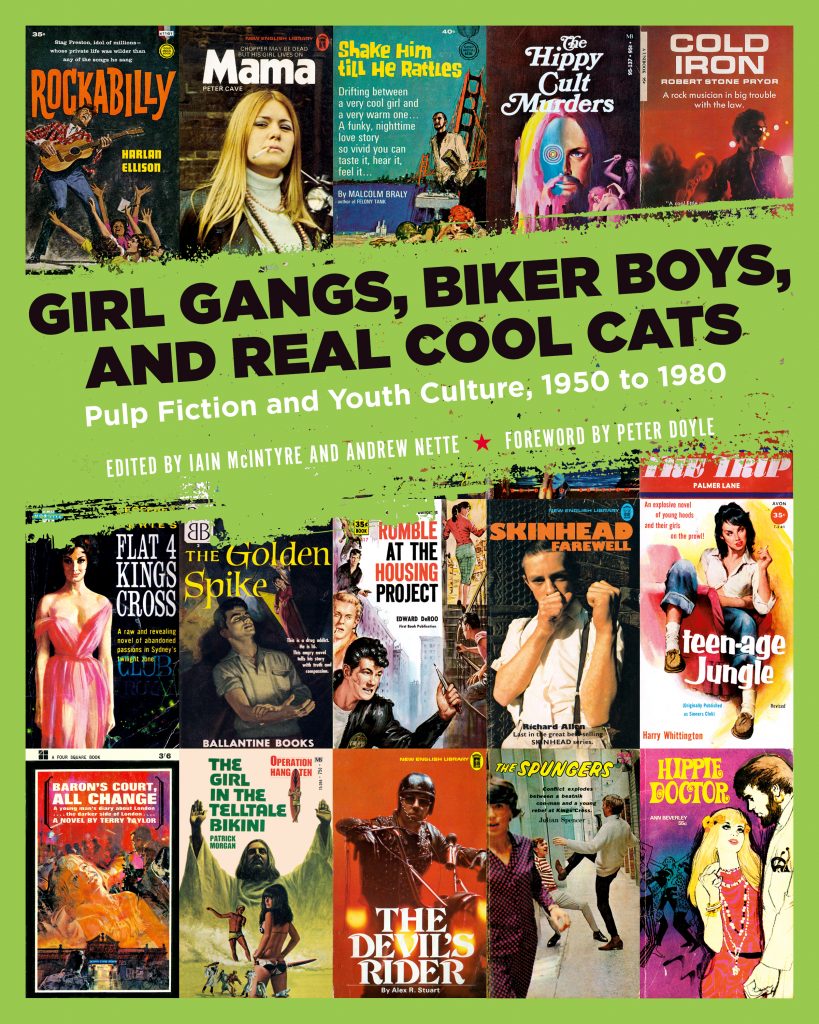By Michael Jongen
The Newtown Review of Books
March 8th, 2018
Iain McIntyre and Andrew Nette have created a loving homage to pulp fiction with its lurid covers and taglines.
This book, lavishly illustrated with pulp covers, is itself a beautiful thing. Its own lurid green cover features a number of pulp images such as the defiant stare of Mama, the chaos of The Spungers, the romantic mood of Hippie Doctor and a cyborg-like Charles Manson staring out from The Hippy Cult Murders.
There are around 400 full-colour covers reproduced in the book, many of which have not been reprinted before. These are a joy. Accompanying them are over 70 essays and in-depth interviews and previously unpublished articles. The layout invites instant perusal and encourages readers to dip into whatever takes their fancy.
Come for the covers — some of which may be familiar or indeed inspire a Proustian moment — but do stay for the essays. These are well researched, informative and fascinating. In his Foreword Peter Doyle looks at the successions of youth subcultures and how the post-World-War-II tabloids flourished in an atmosphere of ‘panic refrains’. (A business model which still seems to work if the tabloids’ current fixation with ‘African crime gangs’ is any indication.)
In the late 1940s, early 1950s it was juvenile delinquents, of course. Then came beatniks. And bikers. Gays and lesbians. Hard-dope fiends. Later on, hippies and counter cultural types, mods, rockers, surfers, skinheads, youthful revolutionaries. Trippers, pot heads and ravers. Rock musicians and groupies. Nearly always the subculture was characterised as a kind of cultish freemason-like quasi-conspiracy or secret society.
I went immediately to the last section of the book, devoted to the late 1960s and early 1970s, which looks at the rise of the teen novel. In Something in the Shadows we are introduced to Marijane Meaker who, I realised, was the woman who as ME Kerr wrote Dinky Hocker Shoots Smack, one of the seminal YA novels (alongside SE Hinton’s The Outsiders) from this period. This is a fascinating look at the introduction of ‘realism’ to children’s books and the beginning of the YA genre. My librarian colleagues who studied under the wonderful Stella Lees will recognise how schooled we were in this emerging literature and will find this a fascinating read. Frank Bonham, Kin Platt and Go Ask Alice are also featured and the backstories of these writers are intriguing.
Meaker relates how she and children’s writer Louise Fitzhugh would lunch and exchange tips about their genres. In 1972, under the name Ann Aldrich, Meaker wrote two gay novels, including the gloriously titled Take a Lesbian to Lunch. I learned more about Meaker in the chapter on Ann Bannon, who published in the lesbian pulp genre.
Bannon speaks of a tentative approach to Meaker, who encouraged her writing:
It was kind of a fan letter. I did not realise she was getting them by the bushel from young women all around the world, but she responded … She said, if you have a manuscript and you can visit me, then I’d like to see it and maybe you can get to meet my editor. This was of course music to the ears of an aspiring young writer, since one of my perplexities had been how to get into print.
It is the writers’ stories that fascinate me. Bannon’s books began being reprinted each decade. On her enduring popularity Bannon muses:
Like my readers, I really thought what I was writing was ephemeral literature, although I wrote it as best I could. I understood the rules, and the rules were that these were throwaway books … Critics ignored us and we flew beneath the radar, which is probably one of the reasons we were allowed to exist. So I had no real belief that they would have a life beyond their initial 6-12 month period of publication.
In the 1990s Bannon was working in a university and owned up to being the author of these pulp titles when her students began submitting Masters and doctoral dissertations on her alter-ego. She suggests that the novels have acquired a very different readership than those ‘who were originally seeking anything about the lesbian experience’.
Another trope is the writers who disappear. Teddy Boy by Ernest Ryman, published in 1958, is tame, however it makes the link between poverty and youth crime. We are informed that history has no record of Ernest Ryman, but the personal histories of these writers of pulp literature are truly fascinating.
There is so much to love in this beautifully curated collection of covers, essays and extracts. There are sections devoted to the novels inspired by the badlands of Sydney’s Kings Cross. Hippie culture is explored, and its evil twin, the hippie cult murder pulps based on the Manson Family. Surf culture is explored by Patrick Morgan and his series featuring William (Bill) Cartwright aimed to cover ‘Surfing. women and whenever possible poking a crooked finger in the hairy eyeball of the establishment’. Librarians will be very familiar with the backstory of our anti-hero; he is the prototype of many a popular series written for the middle grades.
This book is a powerful history of the literature that was written for and about the marginalised. It is our history and I am grateful it has been published in such an inspiring format.
Back to Iain McIntyre’s Author Page | Back to Andrew Nette’s Author Page







